PsychNewsDaily Publishers
100 Summit Drive
Burlington, MA, 01803
Telephone: (320) 349-2484
PsychNewsDaily Publishers
100 Summit Drive
Burlington, MA, 01803
Telephone: (320) 349-2484
Creating a comfortable home for cats involves providing cozy hiding spots, vertical spaces, engaging toys, and establishing routines to reduce stress and enhance their well-being.

Living with a cat means you’re sharing your space with a curious, sensitive little roommate. Even small changes can make a huge difference in how safe and relaxed your cat feels every day.
When you tweak your environment to support your cat’s comfort and security, you help them feel more at ease—and honestly, probably more connected to you, too.
This guide lays out simple, practical ways to cut down stress and make your home more welcoming for your cat. From cozy little hideouts to gentle routines, you’ll find easy tricks that make your cat happier and bring you closer together.
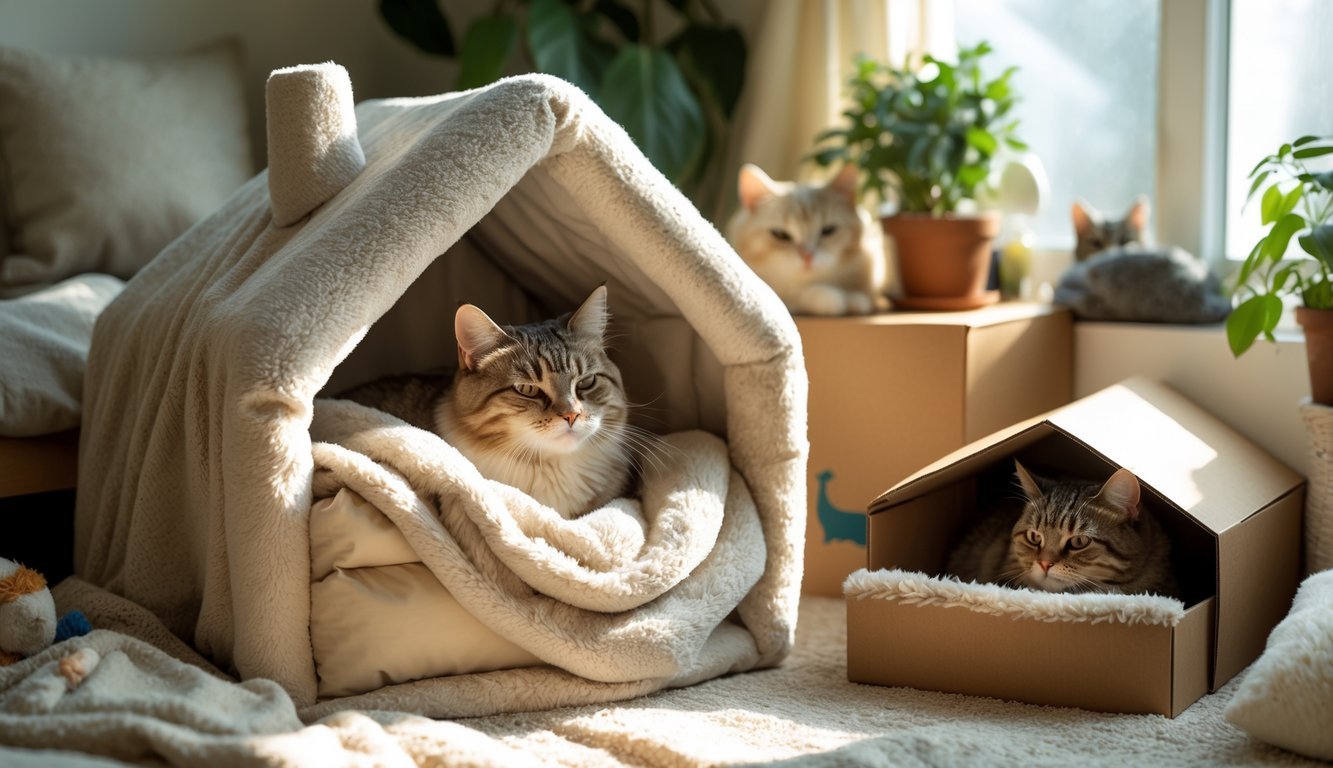
Cats feel safest when they have a private spot to hide away. A covered bed, a cardboard box, or even a blanket tossed over a chair can give your cat that sense of security.
These little spaces help your cat chill out and escape the chaos of the household. You don’t need to buy anything fancy—just grab a sturdy box, line it with a soft towel or an old sweater, and you’re set.
If you want something that lasts, a cat cave or enclosed bed adds warmth and comfort. Try putting these hideouts in quiet corners or near places your cat already likes.
Skip the high-traffic zones so your cat can really relax. You can scatter a few options around your home, letting your cat pick based on their mood.
Cats also love vertical hideouts. A shelf with a blanket or the top of a wardrobe with a cushion can quickly become a favorite perch.
Offer both low and high spots, and your home will feel much safer and cozier for your cat.

Keep your cat active and happy with toys that mimic prey. Feather wands move like birds, and most cats can’t resist chasing and pouncing.
This kind of play lets your cat use their natural hunting instincts in a safe way. Laser pointers are another favorite—cats love darting after that unpredictable red dot.
Just remember to let your cat “catch” an actual toy at the end, so they don’t get frustrated. Mix things up between wands and lasers to keep playtime interesting.
If your cat gets bored with one, another toy might grab their attention again. Rotating toys keeps things fresh and helps your cat stay sharp and engaged.
Even a few minutes of daily play gives your cat good exercise and makes your home feel more fun.
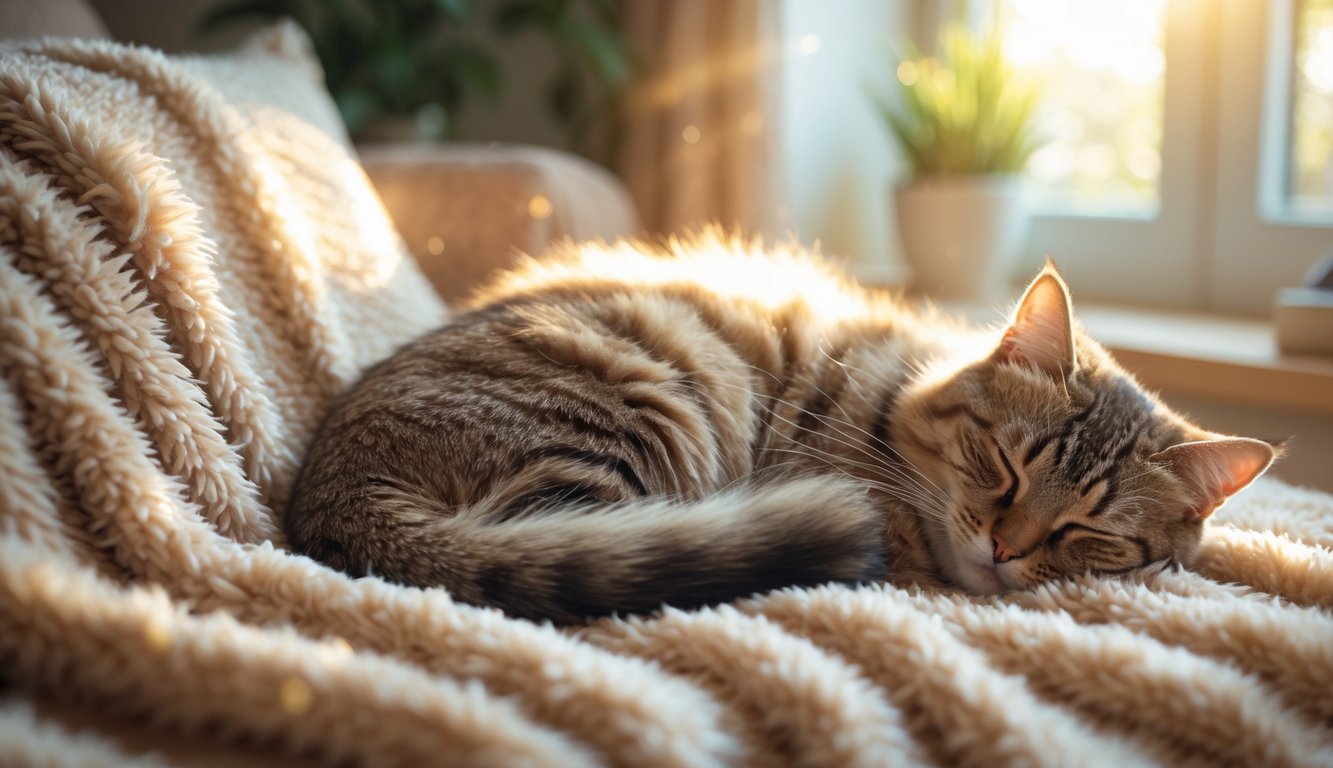
Cats feel safer when they’re surrounded by familiar smells. Try putting out a soft blanket or a piece of your clothing that carries your scent.
Your cat will often pick resting spots based on comfort and security, and something that smells like you offers both. It can make a new or strange place feel a lot more welcoming.
If your cat likes to sleep near you, adding your scent to their favorite spot can encourage them to settle there. This works for beds, couches, or even a cat perch.
You don’t need anything special—a clean but well-worn shirt or a fleece blanket does the trick. The softness gives physical comfort, and your scent adds emotional reassurance.
This can be a lifesaver when you have guests or changes in your home. Your smell gives your cat a little consistency, which can really help during stressful times.

Cats love to climb and watch everything from above. When you give your cat a tall spot, they can relax and keep an eye on their territory at the same time.
This reduces stress and helps them feel more secure. You can use cat trees, wall shelves, or even sturdy furniture you already have.
A solid cat tree gives your cat places to scratch and perch all in one. Wall shelves or steps are great if you don’t have much floor space.
Just make sure everything is stable and safe. Anchor tall cat trees to the wall so they don’t tip, and use strong brackets for shelves.
Keep shelves wide enough for your cat to sit or stretch out. Adding vertical spaces also gives your cat more room to roam.
If you have more than one cat, these extra spots can prevent squabbles. Each cat gets their own perch and feels less crowded.
Try putting a favorite toy, blanket, or even a sprinkle of catnip on the new spot. Your cat will probably be exploring it in no time.
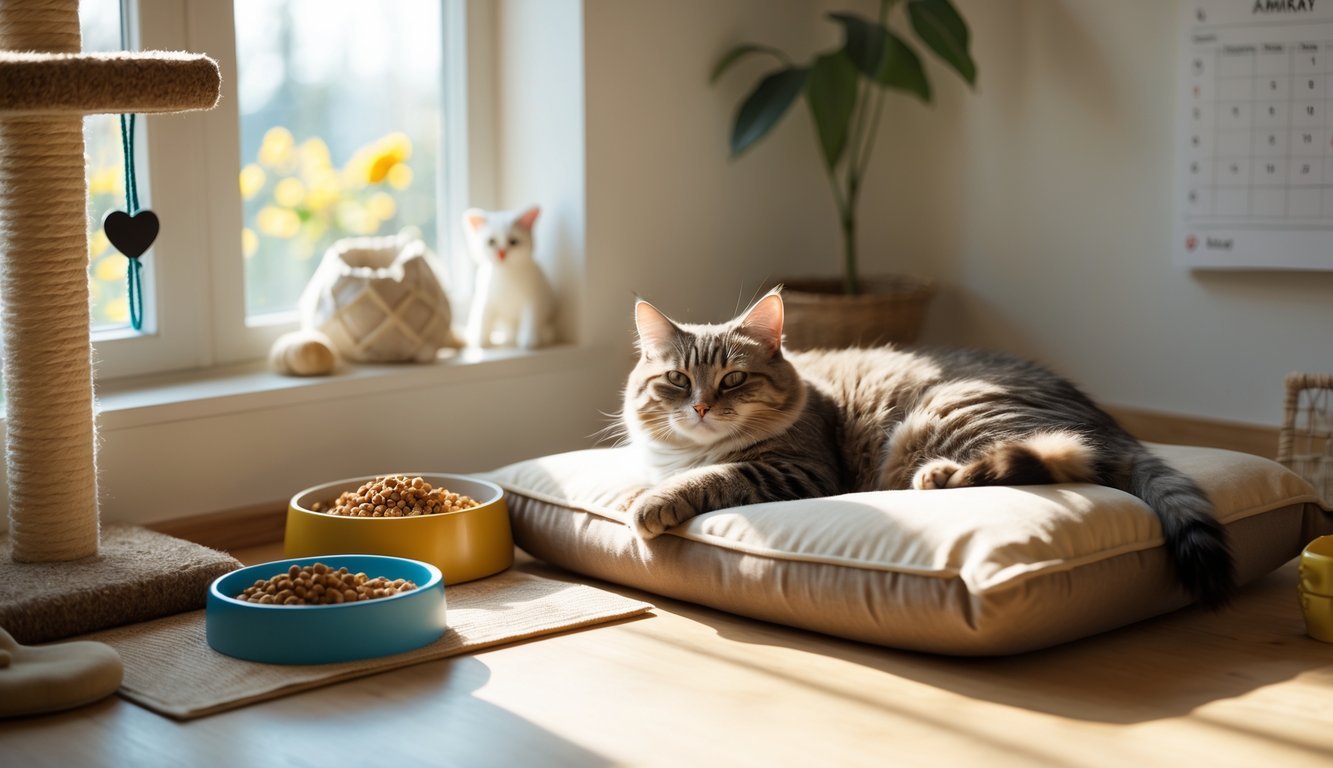
Cats feel more secure when meals happen at the same times every day. A routine lets them know what to expect, which can really lower their stress.
Feeding on a schedule also encourages healthy eating habits. For most adult cats, two meals about 12 hours apart works well.
Kittens usually need smaller, more frequent meals because they’re growing so fast. Keeping a regular routine can help with digestion, too.
When your cat’s body knows when food is coming, it can process nutrients more smoothly. Mealtime can even become a nice bonding moment.
Sitting with your cat while they eat, or offering food in a calm spot, makes feeding time a highlight of their day.
Predictable meal times give your cat comfort and stability, and that supports their overall well-being.
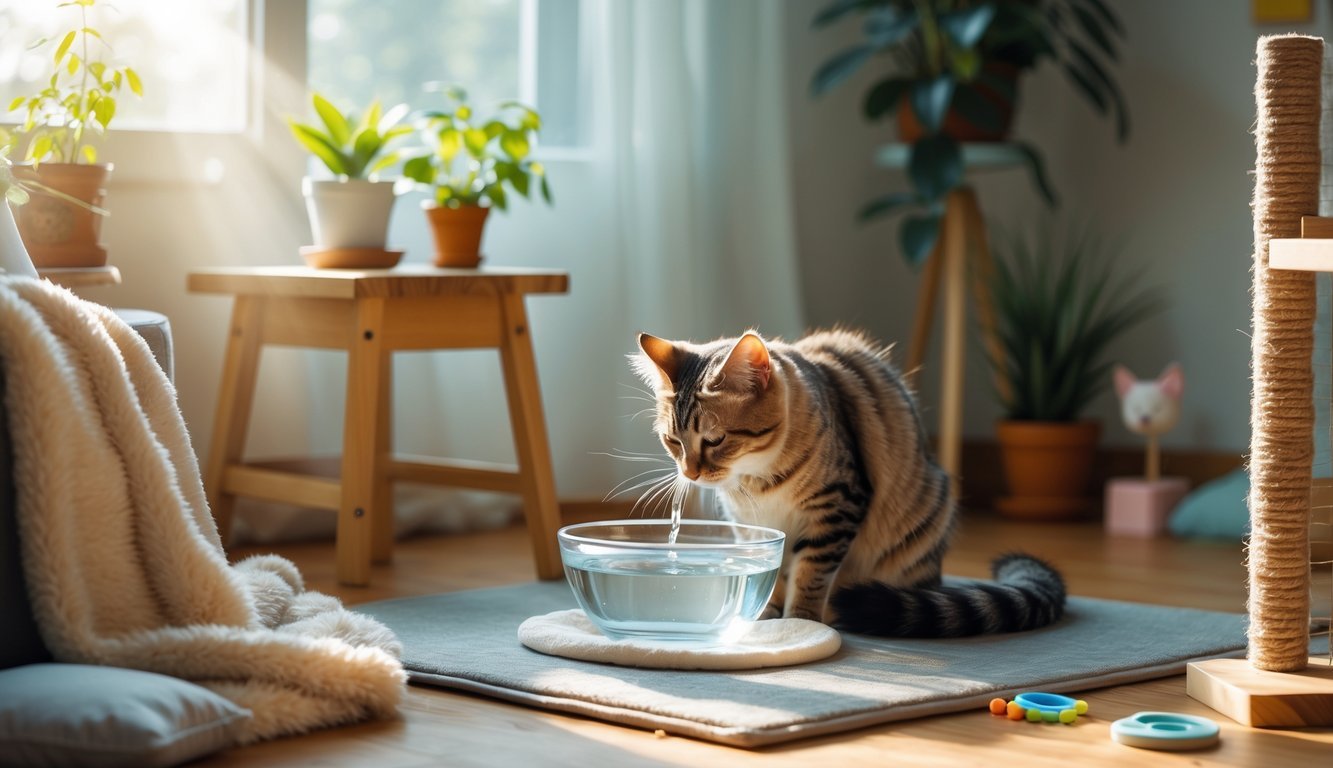
Cats need easy access to clean water every day. Put the bowl in a quiet, low-traffic corner so your cat feels safe while drinking.
Cats usually avoid noisy or busy spots, so a peaceful area is best. Wash and refill the bowl often—cats can be picky, and stale water might put them off.
Use stainless steel or ceramic bowls to keep the water tasting fresh. If your home has multiple rooms, set out more than one bowl.
That way, your cat always has options and won’t get stressed if one area feels crowded. Some cats like moving water, so a pet fountain could be a hit.
The gentle sound and steady flow might encourage them to drink more. Keeping water fresh and the location peaceful gives your cat an easy way to stay comfortable and hydrated.
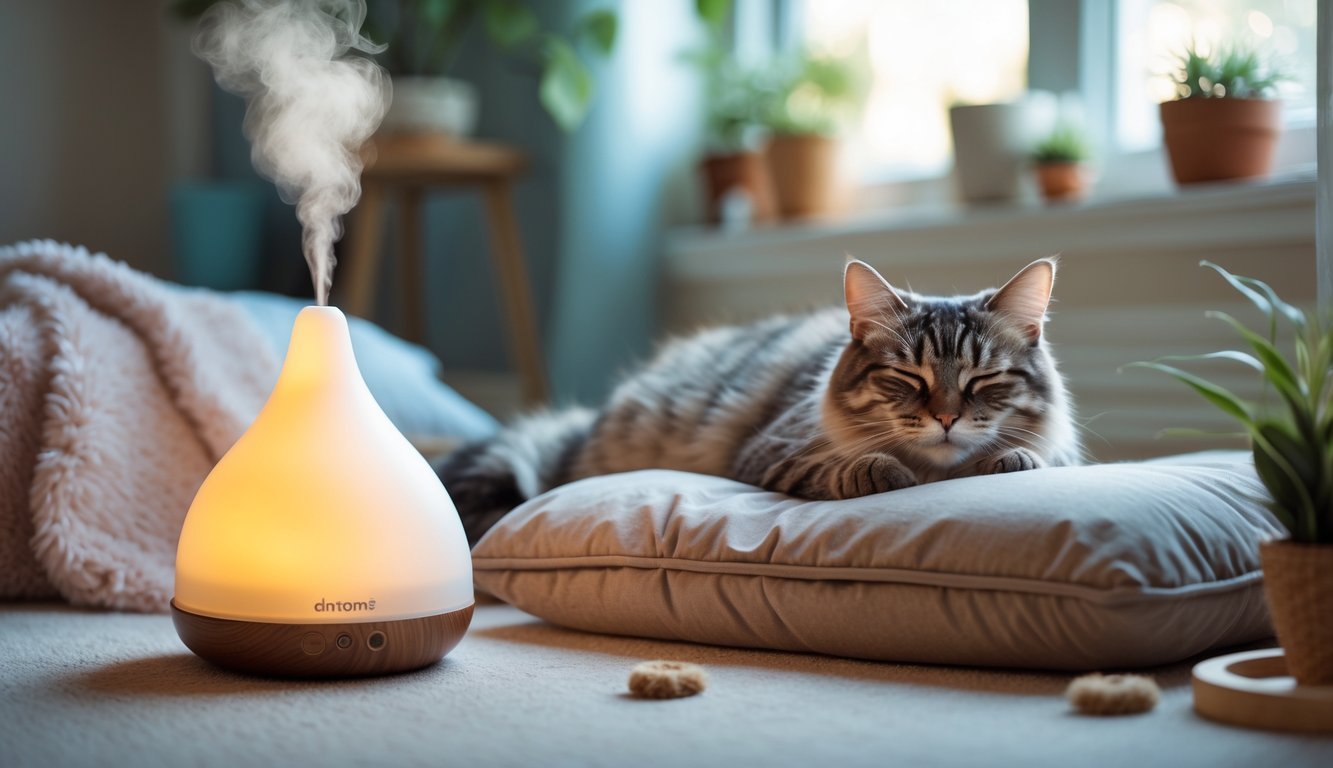
Help your cat feel more relaxed by using a pheromone diffuser. These gadgets release synthetic versions of the natural scents cats make when they’re calm.
Feliway is a popular brand you’ll see. It works like a plug-in air freshener, but instead of a fragrance, it spreads calming pheromones throughout the room.
Many cats show fewer signs of stress, like scratching, hiding, or spraying, when you use these diffusers. Sometimes you’ll notice changes in a few days, but for some cats, it takes a little longer.
Place the diffuser in the room where your cat hangs out most. Keep it plugged in all the time for best results, and swap out the refill when needed.
Pheromone diffusers are safe for other pets and people. While they won’t fix every behavior issue, they can make your cat feel more comfortable at home.
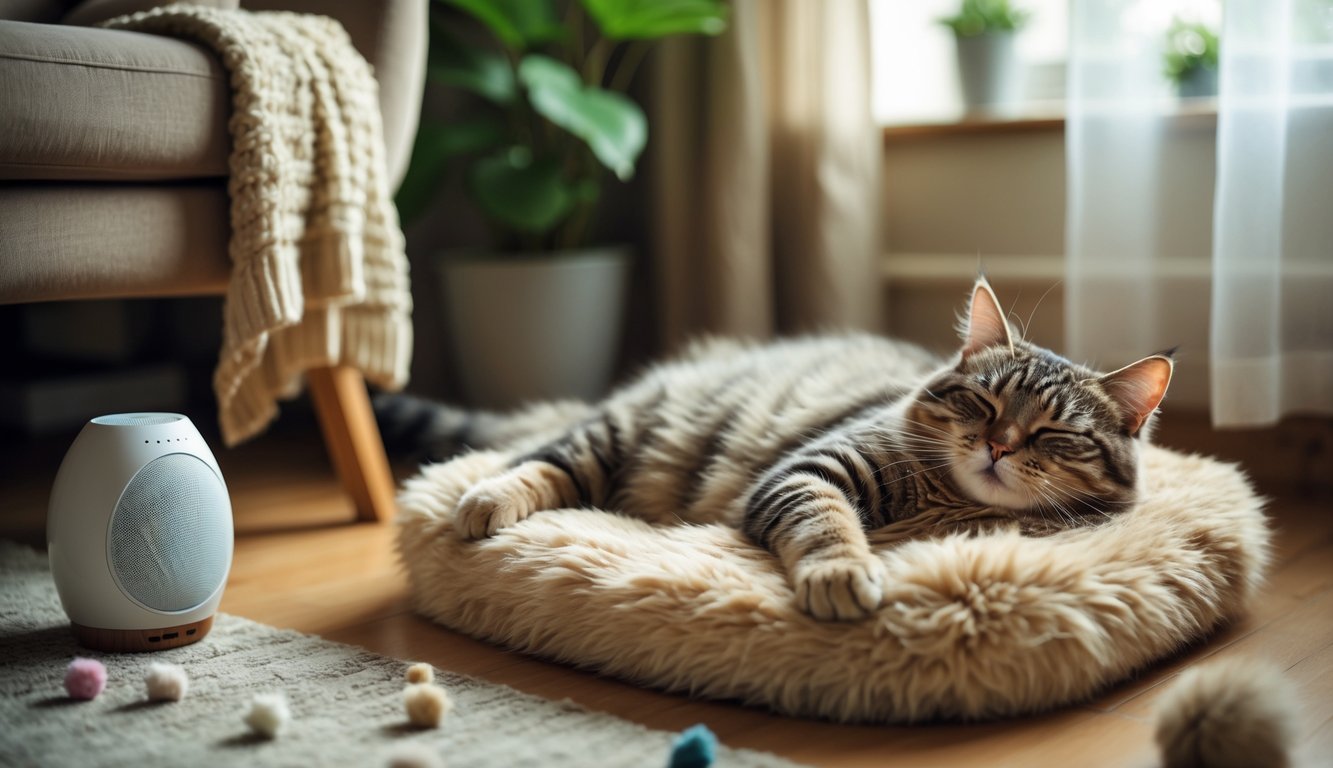
Try using calming sounds to help your cat relax. Soft music or gentle white noise can mask sudden loud noises that might startle your cat.
Classical music, nature sounds, or even tracks made for cats can work nicely. These create a steady background that helps your cat settle down.
If your cat gets anxious when you’re out, playing calming music can help. It gives them something familiar to focus on instead of outside noises.
Some cats love recordings of purring or low-frequency sounds. These mimic natural, comforting rhythms and can be especially soothing.
Keep the volume low so it’s gentle, not overwhelming. Put the speaker in a room where your cat likes to rest, and let the sound play softly in the background.
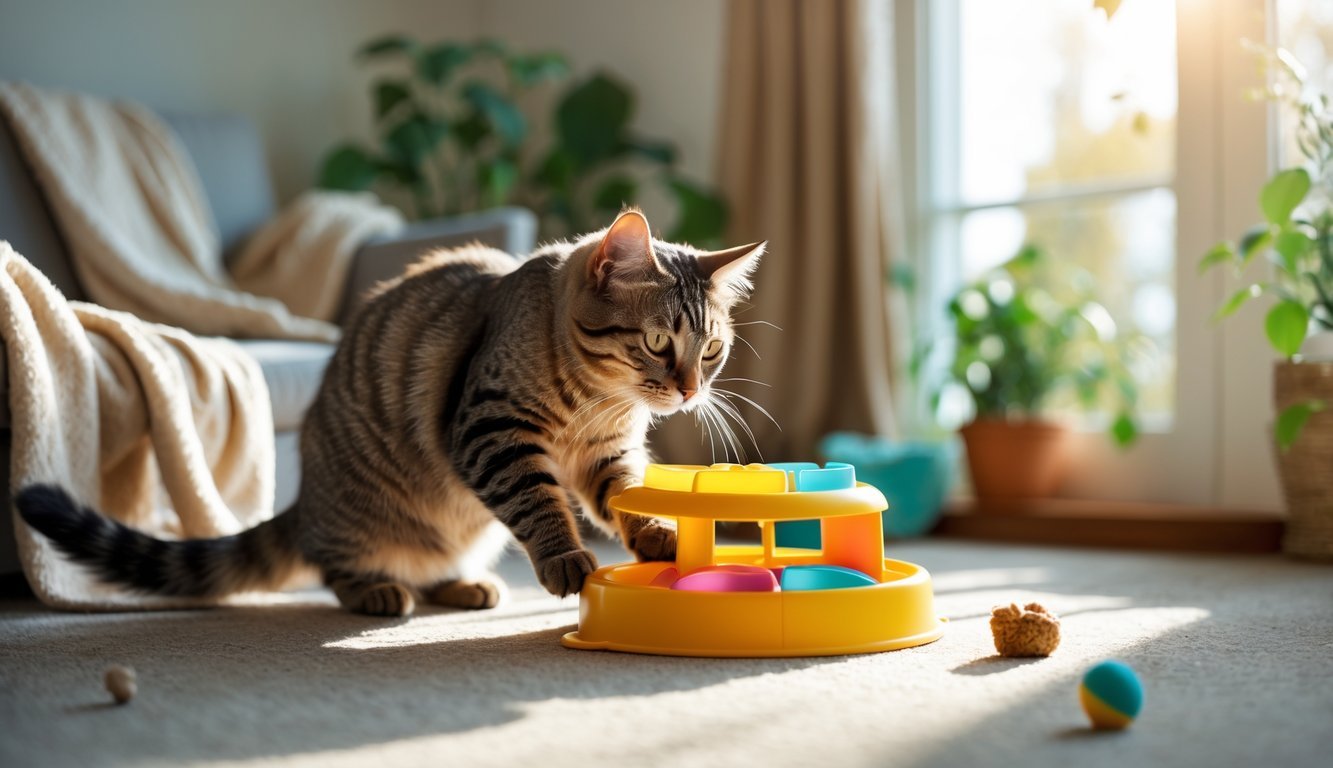
Puzzle feeders give your cat a fun challenge at mealtime. Instead of eating from a regular bowl, your cat has to solve a little puzzle to get the treats or kibble.
This makes meals more interesting and less routine. Puzzle feeders also slow down fast eaters—when your cat eats slower, it can help with digestion and prevent overeating.
These feeders give your cat mental exercise, too. Cats naturally enjoy hunting and problem-solving, and puzzle feeders mimic that process.
You don’t have to spend much to try this. Many puzzle feeders are affordable, and you can make simple ones at home with cardboard boxes or plastic bottles.
Just put food inside and cut small openings for your cat to fish it out. With a bit of patience, your cat will figure it out.
Once they get the hang of it, you’ll probably see them more engaged, calmer, and less bored.
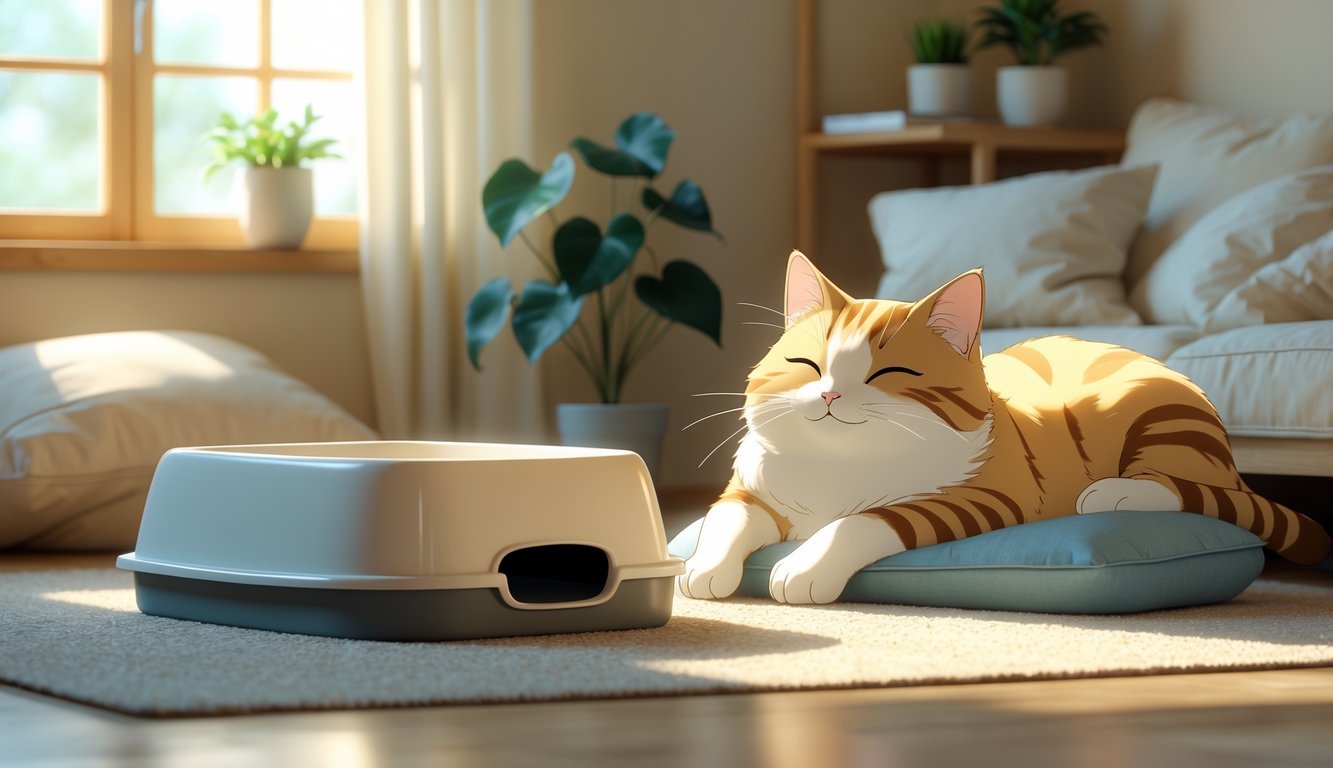
Cats want a clean, private spot to use the bathroom. If the litter box smells or looks dirty, your cat might just avoid it.
Scooping once or twice a day keeps the box fresh and inviting. Put the litter box in a quiet area, away from noise and heavy foot traffic.
Loud places like the laundry room or next to the TV can make your cat uneasy. A calm corner gives them the privacy they like.
If you have more than one cat, make sure you have enough boxes—one per cat, plus one extra, is a good rule. This helps prevent stress and accidents outside the box.
The type of litter box matters, too. Some cats hate covered boxes because they trap odors and feel cramped.
Watch how your cat acts to see what setup they prefer. Regular cleaning and thoughtful placement go a long way.
When the litter box feels safe and clean, your cat will be much more relaxed at home.
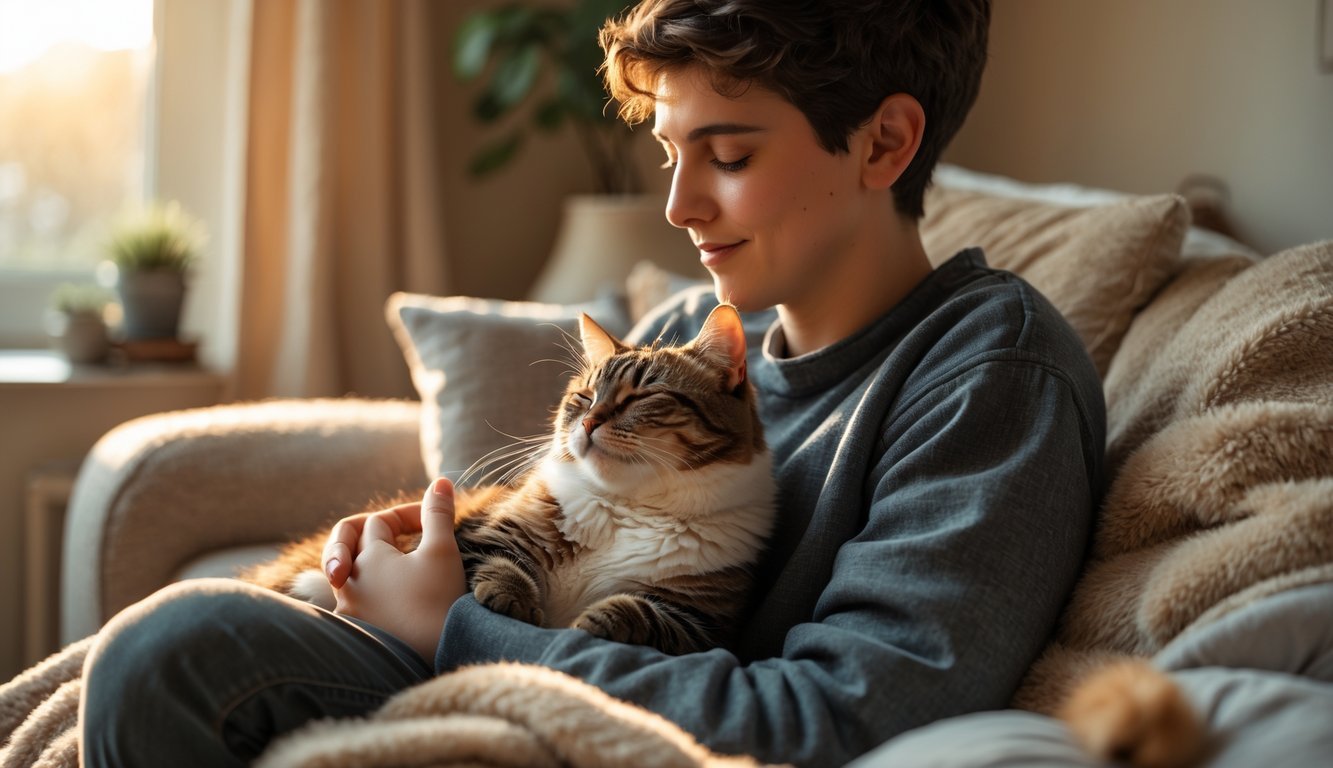
Most cats feel more at ease when you use a calm voice and a gentle touch. If you speak softly while you pet them, they start to connect your presence with comfort.
Try starting with short sessions so your cat doesn’t get overwhelmed. A few strokes on the head, chin, or back usually go over well.
Watch how your cat reacts—if they seem restless or annoyed, just stop. No need to push it.
Talking to your cat while you pet them can make the moment more relaxing for both of you. Even if they don’t get every word, the steady sound of your voice seems to reassure them.
If you make this a regular habit, your cat learns that being near you is pleasant. Over time, they’ll trust you more, and your home will feel safer to them.
Keep your tone gentle and your movements slow. When your cat knows what to expect, they’ll feel a lot more comfortable coming to you.
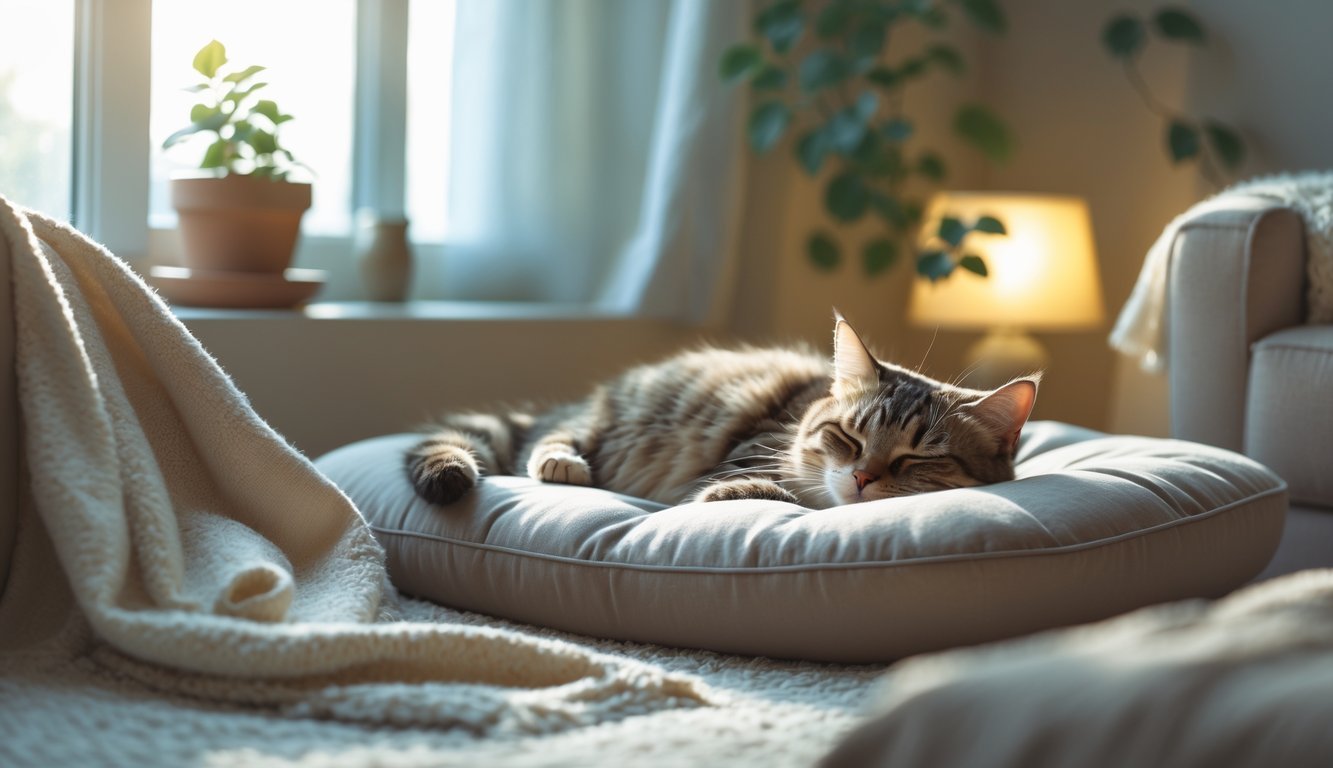
Cats feel safest in a calm, predictable home. Loud sounds, like slamming doors or dropping things, can really startle them and send them running to hide.
Quick, jerky movements tend to have the same effect. So, try to move gently when you’re near your cat, especially if they seem on edge.
Speak in a soft voice and avoid rushing toward them. That way, they see you as safe, not a threat.
If you know a loud noise is coming—maybe you’re vacuuming or moving furniture—give your cat a quiet place to retreat. A cozy hiding spot with a blanket or bed can help them feel secure.
When you keep your actions calm and steady, your cat will start to relax around you. Over time, they might even become less jumpy about everyday sounds.
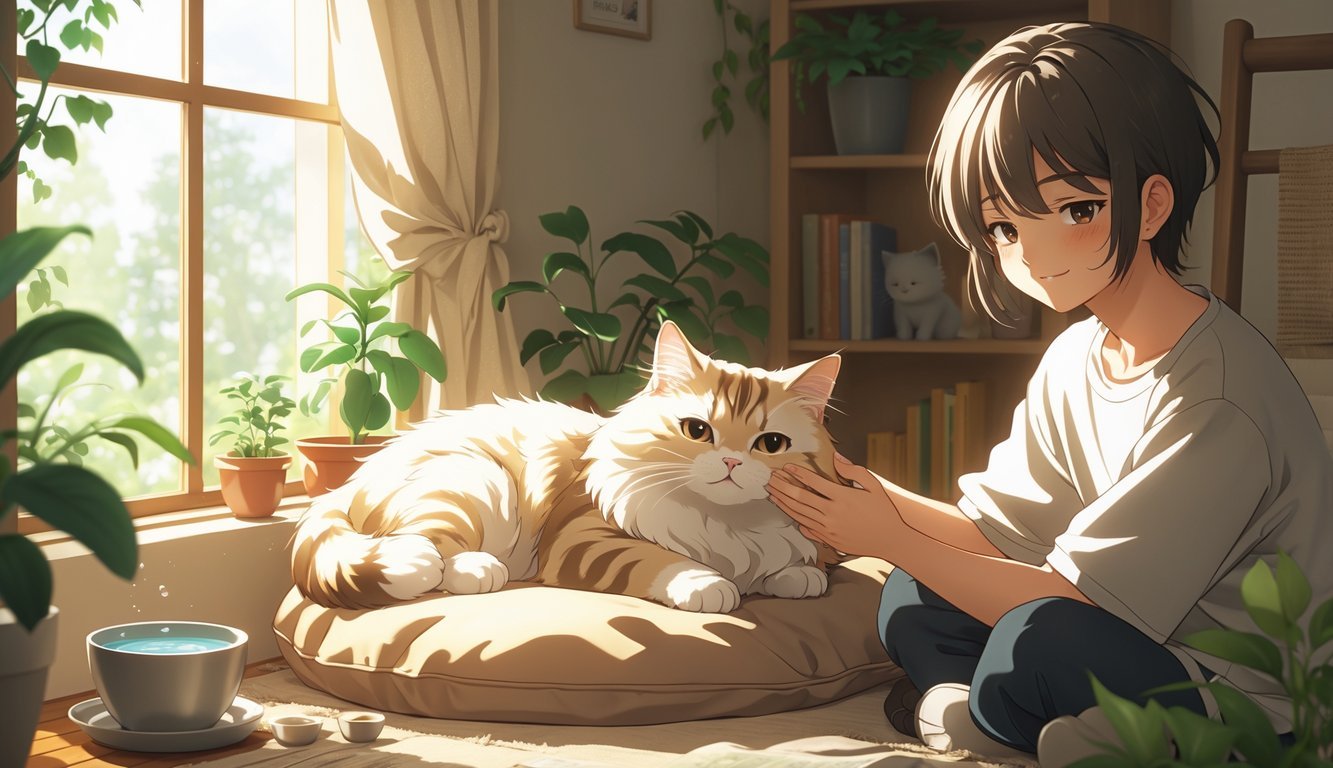
Your cat’s body language and daily actions give you clues about how safe and relaxed they feel. If you learn what signs point to stress and which ones show comfort, you can respond in ways that help your cat feel more secure.
Cats often show stress by changing their behavior and body posture. Maybe they hide under furniture, avoid you, or skip meals.
Some cats over-groom or scratch a lot more when they’re uneasy. Keep an eye on their body language—flattened ears, a twitching tail, or wide eyes usually mean your cat feels threatened.
Even small changes, like less play or not grooming as much, can signal discomfort. Stress can mess with litter box habits too.
If your cat suddenly stops using the box, they might be reacting to tension at home. Loud noises, new pets, or even moving furniture can set them off.
When you track these patterns, you start to see what makes your cat anxious. Once you know the triggers, you can tweak things at home to help them chill out.
When your cat feels safe, they show it with relaxed behavior and calm posture. If you see your cat stretched out on their side, slowly blinking, or kneading with their paws, they’re probably feeling pretty good.
Purring is a big one, though sometimes cats purr when they’re nervous too. So, look at the whole picture.
A relaxed tail—either hanging loosely or curled gently around their body—means they’re at ease. Cats also use closeness to show comfort.
If your cat sits near you, rubs against your legs, or naps beside you, they’re saying they trust you. Here’s a quick list of comfort signs you can spot:
When you notice these signals, you can support your bond and help your cat feel at peace.
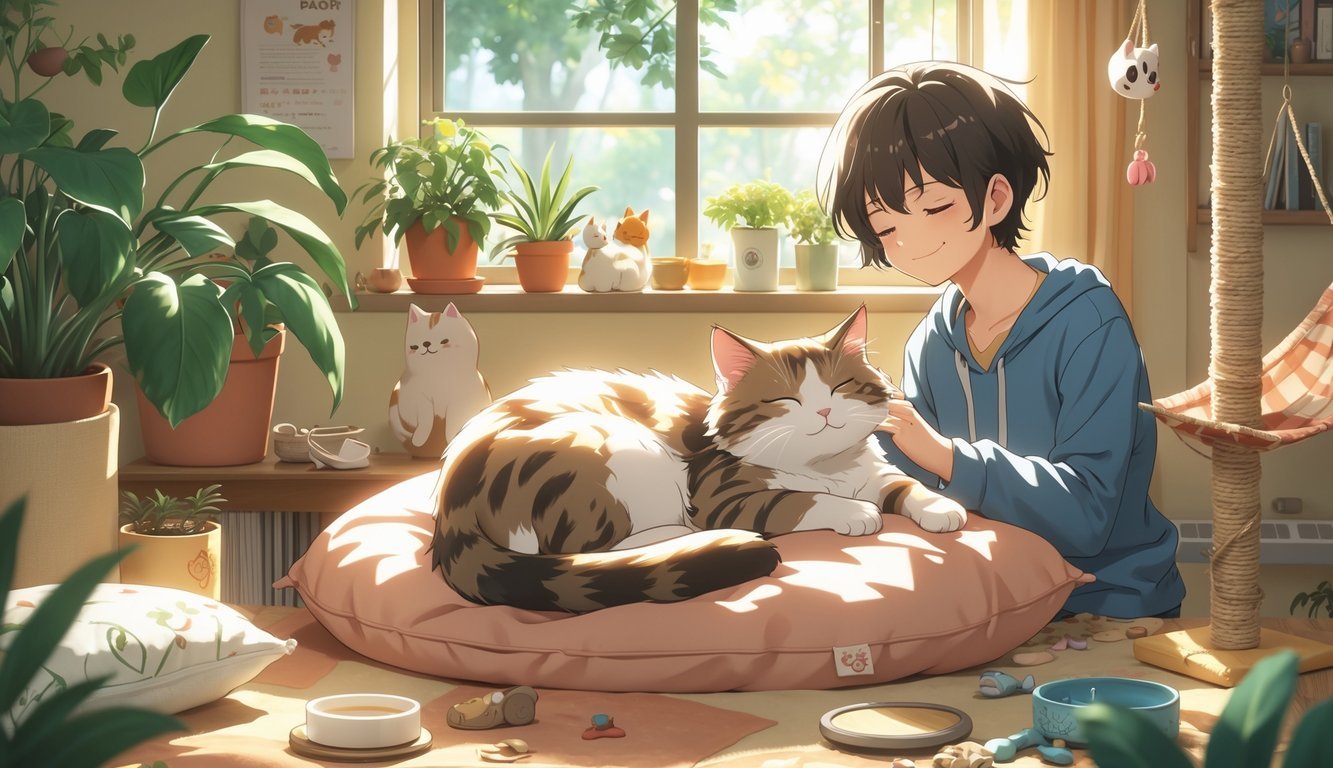
Your cat feels more secure when the home has both high places to climb and cozy spots to hide. If you give them access to vertical spaces and private nooks, you help them relax and act more naturally.
Cats love to watch their world from above. High spots give them control and a sense of safety, especially if your place is busy.
You can add shelves, tall cat trees, or window perches so your cat can climb and rest without being bothered. You don’t need fancy furniture—a sturdy bookshelf, cleared of breakables, can do the trick.
Window hammocks are great too. They offer sunlight and a front-row seat for birdwatching or people-watching.
Ideas for vertical spaces:
Check that all surfaces are stable and won’t tip over. If something feels wobbly, your cat will probably avoid it, so secure furniture to the wall when you can.
Hiding spots give your cat a quiet place to relax when they’re feeling overwhelmed. These cozy spaces can really help cut down on stress from loud noises, visitors, or even other pets.
A great hiding spot feels enclosed, dark, and safe—think of it as a little sanctuary. You can easily set up hideaways with cardboard boxes, covered beds, or those small tents designed for cats.
Try putting these in quiet corners where not many people walk by. Your cat will appreciate a little distance from all the action.
Good hiding spot options:
Skip placing food or litter in these hideouts. Hiding spots work best as a place for rest and comfort, not daily routines. That way, your cat knows it’s a spot they can really count on.